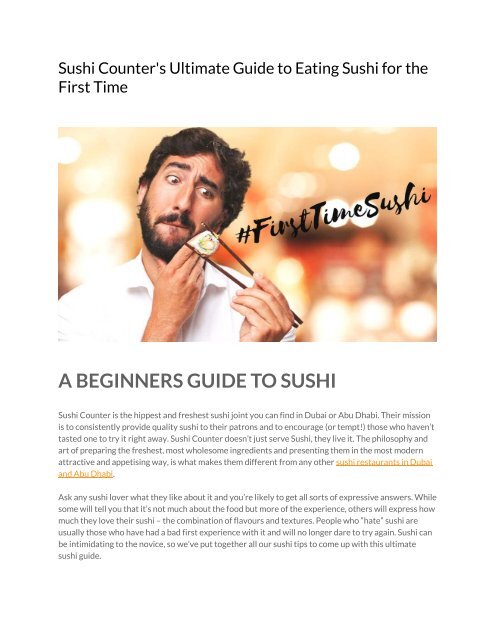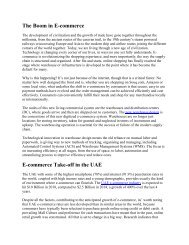Sushi Counter Ultimate Guide to Eating Sushi for the First Time
Sushi can be intimidating so Sushi Counter has put together their sushi tips (the Do's and Don'ts) to come up with this ultimate sushi guide for beginners. Sushi Counter (Bay Square) Bay Square 00971 Dubai, United Arab Emirates +9718002686837 Sushi Counter (Dubai Motor City) Motor City, Control Tower 00971 Dubai, United Arab Emirates +9718002686837 Sushi Counter (CNBC Building, Dubai, United Arab Emirates) CNBC Building 00971 Dubai, United Arab Emirates +9718002686837
Sushi can be intimidating so Sushi Counter has put together their sushi tips (the Do's and Don'ts) to come up with this ultimate sushi guide for beginners.
Sushi Counter (Bay Square)
Bay Square
00971 Dubai, United Arab Emirates
+9718002686837
Sushi Counter (Dubai Motor City)
Motor City, Control Tower
00971 Dubai, United Arab Emirates
+9718002686837
Sushi Counter (CNBC Building, Dubai, United Arab Emirates)
CNBC Building
00971 Dubai, United Arab Emirates
+9718002686837
Create successful ePaper yourself
Turn your PDF publications into a flip-book with our unique Google optimized e-Paper software.
<strong>Sushi</strong> <strong>Counter</strong>'s <strong>Ultimate</strong> <strong>Guide</strong> <strong>to</strong> <strong>Eating</strong> <strong>Sushi</strong> <strong>for</strong> <strong>the</strong><br />
<strong>First</strong> <strong>Time</strong><br />
A BEGINNERS GUIDE TO SUSHI<br />
<strong>Sushi</strong> <strong>Counter</strong> is <strong>the</strong> hippest and freshest sushi joint you can find in Dubai or Abu Dhabi. Their mission<br />
is <strong>to</strong> consistently provide quality sushi <strong>to</strong> <strong>the</strong>ir patrons and <strong>to</strong> encourage (or tempt!) those who haven’t<br />
tasted one <strong>to</strong> try it right away. <strong>Sushi</strong> <strong>Counter</strong> doesn’t just serve <strong>Sushi</strong>, <strong>the</strong>y live it. The philosophy and<br />
art of preparing <strong>the</strong> freshest, most wholesome ingredients and presenting <strong>the</strong>m in <strong>the</strong> most modern<br />
attractive and appetising way, is what makes <strong>the</strong>m different from any o<strong>the</strong>r sushi restaurants in Dubai<br />
and Abu Dhabi.<br />
Ask any sushi lover what <strong>the</strong>y like about it and you’re likely <strong>to</strong> get all sorts of expressive answers. While<br />
some will tell you that it’s not much about <strong>the</strong> food but more of <strong>the</strong> experience, o<strong>the</strong>rs will express how<br />
much <strong>the</strong>y love <strong>the</strong>ir sushi – <strong>the</strong> combination of flavours and textures. People who “hate” sushi are<br />
usually those who have had a bad first experience with it and will no longer dare <strong>to</strong> try again. <strong>Sushi</strong> can<br />
be intimidating <strong>to</strong> <strong>the</strong> novice, so we’ve put <strong>to</strong>ge<strong>the</strong>r all our sushi tips <strong>to</strong> come up with this ultimate<br />
sushi guide.
1. What is <strong>Sushi</strong>?<br />
So, you’ve never had sushi be<strong>for</strong>e but now you’re ready <strong>to</strong> try <strong>the</strong> world’s most popular Japanese food?<br />
We’re going <strong>to</strong> tell you what you’ve been missing and how you should start <strong>to</strong> navigate <strong>the</strong> world of this<br />
versatile cuisine. <strong>Sushi</strong> is a way of preparing food that can go from a street-corner cart <strong>to</strong> <strong>the</strong> most<br />
exclusive establishment. <strong>Sushi</strong> is a famous Japanese method of cooking and serving food, based on rice,<br />
vegetables, egg, and seafood. <strong>Sushi</strong> is often thought of as simply raw fish and rice, but <strong>the</strong>re are<br />
many varieties of sushi nowadays, some don’t even fish at all!<br />
What do you need <strong>to</strong> know about eating sushi?<br />
1. If you like fish (generally), you are going <strong>to</strong> love sushi.<br />
2. If you are a vegetarian or vegan, you can explore more options with cool refreshing veggie based<br />
rolls.<br />
3. If you are health conscious or closely watching your diet, sushi is a great meal choice.<br />
2. A Brief His<strong>to</strong>ry of <strong>Sushi</strong><br />
The origins of <strong>Sushi</strong> are shrouded in <strong>the</strong> mists of time. It is thought <strong>to</strong> have originated in ancient China,<br />
where people used cooked rice <strong>to</strong> start a fermentation process <strong>to</strong> preserve fish. Moving <strong>to</strong> Japan, this
method of preserving and serving fish in rice became popular in <strong>the</strong> 9th century alongside <strong>the</strong> adoption<br />
of Buddhism, as Buddhists abandoned eating meat and consumed rice, vegetable and small amounts of<br />
fish instead. Through <strong>the</strong> centuries, people adapted and changed <strong>the</strong> methods of preparing and serving<br />
sushi, speeding up <strong>the</strong> process of fermentation and finally beginning <strong>to</strong> serve fresh ra<strong>the</strong>r than<br />
preserved fish. <strong>Sushi</strong> was also once a food reserved <strong>for</strong> <strong>the</strong> elite because of <strong>the</strong> labour and expense<br />
involved in preparing it.<br />
Finally, in <strong>the</strong> early 19th century, a modern <strong>for</strong>m of sushi was invented by street stall vendor, Hanaya<br />
Yoehi in what is now modern-day Tokyo. Ra<strong>the</strong>r than fermenting fish in packed salted rice, Yoehi<br />
developed a new style of tasty street food by adding vinegar and salt <strong>to</strong> just cooked rice served with<br />
slices of raw fresh fish. Soon, hundreds of o<strong>the</strong>r street food vendors began copying Yoehi’s innovation<br />
and this style of sushi spread throughout Japan.<br />
In <strong>the</strong> 1960s, Japanese businessmen living in Cali<strong>for</strong>nia imported <strong>the</strong>ir favourite food. The first<br />
restaurant serving sushi opened in 1966 in Little Tokyo area. For <strong>the</strong> first time, Americans were able <strong>to</strong><br />
try sushi and <strong>the</strong> little Japanese cuisine became widely known. Soon, American-based chefs began <strong>to</strong><br />
innovate - creating <strong>the</strong> first <strong>Sushi</strong> “rolls” and adding untraditional ingredients like avocado and cream<br />
cheese. From America, sushi restaurants started <strong>to</strong> pop up all around <strong>the</strong> world, eventually becoming<br />
one of <strong>the</strong> most popular and recognizable global cuisines.
3. Health Benefits of <strong>Sushi</strong> (and Warning!)<br />
<strong>Sushi</strong> is packed with nutrients because it relies on fish and vegetables as <strong>the</strong> main ingredients. Fish<br />
provides a lean source of low-calorie, high-quality protein. It's also low in saturated fats and<br />
cholesterol, making it a heart-healthy food choice. A healthy diet should incorporate fish at least twice<br />
a week, according <strong>to</strong> <strong>the</strong> American Heart Association. This is because fish contains high amounts of<br />
Omega-3 fatty acids, which are essential <strong>to</strong> <strong>the</strong> healthy functioning of <strong>the</strong> brain. Omega-3 fatty acids<br />
are helpful <strong>for</strong> neurological disorders and may help <strong>to</strong> fight depression, ADHD, Alzheimer’s, dementia<br />
and diabetes. Fish also contains o<strong>the</strong>r healthy vitamins and minerals such as Vitamin D.<br />
The seaweed wrapping of sushi rolls, Nori, is packed with nutrients. It is low in calories and contains<br />
vitamins A, B-6, and C. It also has a healthy serving of Iodine, which is essential <strong>for</strong> hormone function.<br />
Recent studies indicate that seaweed proteins may reduce blood pressure and improve heart health.<br />
<strong>Sushi</strong>, however healthy it is, is not always a low-calorie option. Because <strong>the</strong> portions are small, it can be<br />
very easy <strong>to</strong> load up, taking in more calories than necessary, especially if o<strong>the</strong>r ingredients and<br />
condiments are added like cream cheese and mayonnaise. So, if you start <strong>to</strong> crave <strong>for</strong> more sushi after<br />
your first order, try o<strong>the</strong>r delicious yet lighter options such as <strong>the</strong> vegan varieties.<br />
<strong>Eating</strong> <strong>Sushi</strong> <strong>for</strong> <strong>the</strong> <strong>First</strong> <strong>Time</strong>
1. Navigating <strong>the</strong> Menu<br />
A sushi menu may seem complicated <strong>to</strong> <strong>the</strong> newbie, but <strong>the</strong>re are basically four kinds of <strong>Sushi</strong>.<br />
<br />
<br />
<br />
<br />
Nigiri <strong>Sushi</strong> – It is a small serving of cold molded rice with a slice of raw fish on <strong>to</strong>p. The first<br />
type of sushi was developed in Japan and considered <strong>the</strong> most traditional of all <strong>the</strong> sushi types.<br />
Maki is a combination of rice, vegetables and fish rolled up in tightly in thin sheets of flattened<br />
dried seaweed, called “Nori”. Maki is served sliced in<strong>to</strong> six or eight pieces. Sometimes, <strong>the</strong> rolls<br />
(uramaki) are served inside out with <strong>the</strong> rice on <strong>the</strong> outside, while <strong>the</strong> nori and fish or<br />
vegetables in <strong>the</strong> middle. Maki can also be served as a kind of seaweed cone (temaki) filled with<br />
rice, fish and/or veggies.<br />
Chirashi is a bowl of vinegared rice with a piece of fish on <strong>to</strong>p.<br />
Sashimi is a thin slice of raw fish. In some cases, <strong>the</strong> rice is served on <strong>the</strong> side, though it is not<br />
really necessary.<br />
<strong>Sushi</strong> can be a disorienting experience if you are not used <strong>to</strong> it especially when <strong>the</strong>y are served and<br />
eaten cold. Many restaurants, like <strong>Sushi</strong> <strong>Counter</strong>, will also have o<strong>the</strong>r cooked and hot items on <strong>the</strong><br />
menu like soups, and noodles alongside o<strong>the</strong>r Asian inspired hot main dishes, like curries, so <strong>the</strong>re is no<br />
need <strong>to</strong> worry if you really don’t like cold food.<br />
2. Ordering Tips<br />
If you are having sushi <strong>for</strong> <strong>the</strong> first time, it is a good idea <strong>to</strong> be with friends who are already sushi<br />
enthusiasts. Ano<strong>the</strong>r option is <strong>to</strong> ask <strong>the</strong> sushi chef <strong>for</strong> guidance on what and how much <strong>to</strong> order. As a<br />
beginner, it’s best <strong>to</strong> go slow and ease your way in<strong>to</strong> <strong>the</strong> wonderful world of sushi. <strong>Sushi</strong> is prepared<br />
with only a handful of ingredients, but <strong>the</strong> combination of flavours, textures, and tastes is amazing.<br />
Since sushi has evolved through its long his<strong>to</strong>ry, restaurants of <strong>to</strong>day are constantly innovating and<br />
adding new combinations, which are just as au<strong>the</strong>ntic as traditional sushi. This is part of what makes<br />
this cuisine so interesting.<br />
Start slowly by choosing items that are more familiar or those with ingredients that you are more<br />
com<strong>for</strong>table with until you become accus<strong>to</strong>med <strong>to</strong> <strong>the</strong> textures and flavours unique <strong>to</strong> sushi. It’s also<br />
good <strong>to</strong> prepare yourself mentally. If you encounter something you don’t like, don’t <strong>for</strong>ce yourself.<br />
<strong>Sushi</strong> should be a fun learning experience. Leave it and try something else. Below are some o<strong>the</strong>r tips<br />
that may be helpful <strong>for</strong> your first take on sushi.<br />
Try Cooked <strong>Sushi</strong> Dishes <strong>First</strong><br />
Not all <strong>Sushi</strong> are raw. Eel (unagi and anago) is always served cooked, usually with a sweet and savoury<br />
sauce. Cali<strong>for</strong>nia rolls have avocado, cucumber and cooked crab meat (called kamaboko or surimi).<br />
Squid (ika) or oc<strong>to</strong>pus (ika) are served grilled. Many restaurants also serve items like tempura (battered<br />
and fried), noodles and soups. Opt <strong>for</strong> those <strong>for</strong> a start.<br />
Eat <strong>Sushi</strong> with Familiar Ingredients<br />
If you are an adventurous fish lover, do try Sashimi, one of <strong>the</strong> most popular sushi dishes served
without rice. As mentioned above, sashimi is a thin slice of raw fish. Choose <strong>the</strong> fish you have already<br />
tasted be<strong>for</strong>e like Salmon or Tuna. Chances are, if you liked <strong>the</strong> cooked or smoked version of <strong>the</strong> fish,<br />
you will likely <strong>to</strong> enjoy its fresh <strong>for</strong>m.<br />
Start with Maki Rolls<br />
The best sushi <strong>for</strong> beginners is Maki. Cali<strong>for</strong>nia rolls don't have raw ingredients. The only thing that is<br />
raw in this sushi are <strong>the</strong> vegetables. Even if you pick a variety with raw fish, <strong>the</strong> taste will not be<br />
overpowering because of <strong>the</strong> flavour of <strong>the</strong> seaweed and vegetables. You also won’t have <strong>to</strong> stare at,<br />
perhaps, an intimidating slice of raw seafood on your plate.<br />
Stick <strong>to</strong> Vegetarian <strong>Sushi</strong><br />
If you’re still not ready <strong>to</strong> order something with raw fish, you can also opt <strong>for</strong> <strong>the</strong> vegetable-based<br />
sushi. <strong>Sushi</strong> <strong>Counter</strong> has many varieties including Sun Dried Toma<strong>to</strong> Basil Roll, Hummus & Cucumber<br />
Roll and Black Veggie Roll.<br />
How <strong>to</strong> Eat it: <strong>Sushi</strong> Do’s & Don’ts<br />
There are certain basic rules of etiquette and cus<strong>to</strong>ms around sushi just like <strong>the</strong>re are with eating any<br />
o<strong>the</strong>r kinds of cuisines. Here are <strong>the</strong> main things you should keep in mind.
Hands<br />
DO: Wash your hands. Your restaurant may provide you with a hot <strong>to</strong>wel <strong>to</strong> wipe your hands be<strong>for</strong>e<br />
you begin <strong>to</strong> eat.<br />
Check which items should be eaten by hand and which by chopsticks <strong>to</strong> avoid embarrassment.<br />
<strong>Sushi</strong> was traditionally eaten by hand. Maki and nigiri both should always be eaten by hand. Only<br />
sashimi and Chirashi require chopsticks.<br />
DON'T: Do not lift Sashimi <strong>to</strong> your mouth with your fingers, and don’t eat <strong>the</strong> rice by hand.<br />
Don’t cut up your food. Most sushi is meant <strong>to</strong> be eaten in one bite. It will taste better.<br />
Chopsticks<br />
DO: Some kinds of <strong>Sushi</strong> are eaten with chopsticks. If you don’t know how <strong>to</strong> use <strong>the</strong>m, ask your<br />
restaurant if <strong>the</strong>y provide “training” sticks, which are attached at <strong>the</strong> <strong>to</strong>p, or you can make your own<br />
set, by winding a rubber band around <strong>the</strong> <strong>to</strong>p of a pair of chopsticks. You can use <strong>the</strong>se <strong>to</strong> eat by<br />
manipulating <strong>the</strong> sticks like pincers <strong>to</strong> pick up food items.<br />
DON'T: Never rub your chopsticks <strong>to</strong>ge<strong>the</strong>r. This is considered rude. The habit originated with cheap<br />
establishments using poorly made chopsticks. Patrons rubbed <strong>the</strong> sticks <strong>to</strong>ge<strong>the</strong>r <strong>to</strong> get rid of splinters.<br />
If you copy this practice, you are implying that <strong>the</strong> restaurant you are patronising is cheap.<br />
Ordering<br />
DO: Order a few items that you are sure <strong>to</strong> eat. If you finish what you have ordered, order again.<br />
Share items with your dining companions. Experiment and ask your chef or server <strong>for</strong> order<br />
recommendations.<br />
DON'T: Never ask <strong>for</strong> a doggie bag. <strong>Sushi</strong> should be eaten fresh and should not kept <strong>for</strong> long periods.<br />
Sauces & Condiments<br />
DO: <strong>Sushi</strong> is served with three traditional sauces:<br />
<br />
<br />
<br />
Soy sauce: a staple of Asian cuisine. Just pour a little soy sauce in<strong>to</strong> a dish <strong>for</strong> dipping. Dunk <strong>the</strong><br />
fish side of <strong>the</strong> sushi.<br />
Wasabi: a fiercely hot sauce traditionally made from a Japanese <strong>for</strong>m of <strong>the</strong> horseradish root. It<br />
is used <strong>to</strong> soften <strong>the</strong> smell of <strong>the</strong> raw fish while bringing out <strong>the</strong> flavour in each bite. It can be<br />
quite intense so try carefully <strong>the</strong> first time. If you like <strong>the</strong> taste, use it sparingly. The chef<br />
already added a portion <strong>to</strong> your sushi, but if you still want it <strong>to</strong> be extra hot, you can add a small<br />
amount on <strong>the</strong> fish.<br />
Pickled ginger is served <strong>to</strong> cleanse <strong>the</strong> palate between dishes or bites. Consume it after you’ve<br />
eaten a piece of sushi.
DON'T: It is rude <strong>to</strong> pour <strong>to</strong>o much soy sauce in <strong>the</strong> dish and <strong>to</strong> leave it unused.<br />
Only pour a fair amount and refill as necessary.<br />
Never drown your <strong>Sushi</strong> in <strong>the</strong> Soy Sauce. It is considered a no-no <strong>to</strong> dip your rice in <strong>the</strong> soy sauce<br />
because it will cause it <strong>to</strong> fall apart.<br />
Don’t add any condiments when eating Nigiri because it is assumed that <strong>the</strong> chef has already added <strong>the</strong><br />
perfect amount and any more will be insulting <strong>to</strong> his skill. You can add as much soy sauce and wasabi as<br />
you like <strong>to</strong> Sashimi.<br />
Don’t overdo <strong>the</strong> Wasabi. Don’t trust anybody who tells you it’s Japanese pistachio ice cream and<br />
offers you a big gob of it.<br />
Don’t eat <strong>the</strong> pickled ginger with your sushi. It’s meant <strong>to</strong> be eaten by itself.<br />
<strong>Eating</strong> your Meal<br />
DO: Feel free <strong>to</strong> open your mouth as wide as possible <strong>to</strong> fit in <strong>the</strong> <strong>Sushi</strong>. Chew slowly and savour <strong>the</strong><br />
flavours. To fully enjoy your sushi experience, <strong>the</strong>re is a certain recommended order <strong>to</strong> eating <strong>the</strong> fish.<br />
Go from <strong>the</strong> lighter <strong>to</strong> <strong>the</strong> darker coloured pieces, starting from white fish <strong>to</strong> red fish. This means you<br />
will be moving from a lighter flavour <strong>to</strong> a fattier one. Save <strong>the</strong> fattiest and darkest fish types <strong>for</strong> last.<br />
DON'T: Don’t bite <strong>the</strong> sushi halfway. It should be eaten in one bite <strong>to</strong> experience <strong>the</strong> balance of<br />
flavours.<br />
Once you have finished don’t linger. It is considered rude.<br />
Never ask <strong>for</strong> a doggie bag. If you want <strong>to</strong> eat <strong>Sushi</strong> at home <strong>the</strong>n ask <strong>for</strong> specifically prepared takeaway.<br />
<strong>Sushi</strong> is best eaten fresh, and takeaway orders will be packed and wrapped in a way <strong>to</strong> preserve<br />
<strong>the</strong>ir freshness.<br />
What are you waiting <strong>for</strong>: Try <strong>Sushi</strong> Today<br />
You may not be com<strong>for</strong>table with <strong>the</strong> idea of eating “raw” fish, but sushi is much more than that. It is<br />
<strong>the</strong> perfect foodie experience even <strong>for</strong> newbies. It can be shared with friends after your hangout; it can<br />
be a new, fun & exciting addition <strong>to</strong> your catering menu; as well as a quick and filling take-away or<br />
delivery option. Its defining characteristic is its beauty, minimalism and unfussiness: High-quality fresh<br />
ingredients, perfectly prepared rice, a feast <strong>for</strong> <strong>the</strong> eyes as well as <strong>the</strong> palate. There are plenty of o<strong>the</strong>r<br />
options <strong>to</strong> choose from until you work your way up <strong>to</strong> Nigiri or Sashimi. Drop by <strong>Sushi</strong> <strong>Counter</strong> <strong>to</strong>day<br />
and ask <strong>the</strong>m <strong>to</strong> help you choose among <strong>the</strong>ir abundant and modern menu items, or order a delivery <strong>to</strong><br />
your home or workplace. <strong>Sushi</strong> <strong>Counter</strong> has an extensive selection of traditional rolls, hand rolls, and<br />
sashimi. They also offer poke bowls, street food innovations, and vegan choices. You can also choose<br />
hot items like soups or noodles, or just opt <strong>to</strong> munch on <strong>the</strong>ir salads. There are just a lot of food menu
options <strong>to</strong> choose from if you want <strong>to</strong> try o<strong>the</strong>r Japanese dishes. Get out of your com<strong>for</strong>t zone <strong>to</strong>day<br />
and experience <strong>the</strong> fun in sushi. You owe it <strong>to</strong> yourself.<br />
<strong>Sushi</strong> <strong>Counter</strong> (Bay Square)<br />
Bay Square<br />
00971 Dubai, United Arab Emirates<br />
+9718002686837<br />
<strong>Sushi</strong> <strong>Counter</strong> (Dubai Mo<strong>to</strong>r City)<br />
Mo<strong>to</strong>r City, Control Tower<br />
00971 Dubai, United Arab Emirates<br />
+9718002686837<br />
<strong>Sushi</strong> <strong>Counter</strong> (CNBC Building, Dubai, United Arab Emirates)<br />
CNBC Building<br />
00971 Dubai, United Arab Emirates<br />
+9718002686837<br />
https://www.sushicounter.com/blog/ultimate-guide-<strong>to</strong>-eating-sushi
















